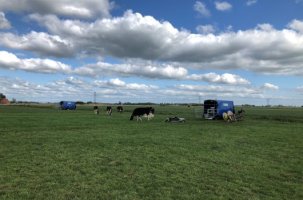
category_news
Grass decomposition in the rumen
In order to understand how grass quality affects methane emissions, we need to know what happens in the rumen. How is grass broken down in the rumen and how can we control the quality through grassland management in such a way that methane emissions can be reduced?
Part of the pasture trial
As part of the Grassland Management project as a measure to reduce methane & ammonia emissions, additional research is currently being conducted at Dairy Campus. Due to the extensive sampling of grass quality, degradation characteristics and methane emissions, this research can provide insight into how we can steer grassland management to reduce methane emissions.
Nylon bag test
The method in this research uses small (10 * 19 cm) nylon bags containing the pasture grass to be examined. The bag with grass is in the cow's rumen for a certain period of time. During that time the grass is broken down by micro-organisms. The remainder that remains in the bag is then weighed and analyzed. This shows how much of the grass is fermented in the rumen and how much is "resistant" to intestinal digestion. The properties of the grass samples determine to a large extent the speed at which the nutrients are broken down. The main nutrients in grass are protein, cell walls and sugars.
The results, including the breakdown rate of the nutrients, are the building blocks for the calculation of the DVE and OEB values of grass. Feed samples from practice are often analyzed using the NIRS methodology derived from this.
The first results are expected in the spring of 2021.

